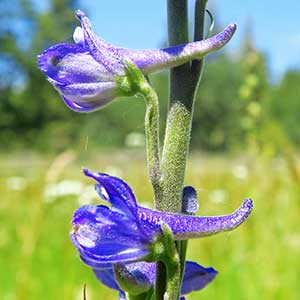Delphinium distichum
Delphinium bicolor
Burke's larkspur, meadow larkspur, strict larkspur, two-spike larkspur
Flathead larkspur, little larkspur, low larkspur, Montana larkspur
(25-)30-60(-80) cm;
base sometimes reddish, puberulent.
10-40(-70) cm;
base often reddish, glabrous to puberulent.
blade cuneate to semicircular, 1-5 × 1.5-7 cm, puberulent; ultimate lobes 5-19, width 2-8(-15) mm (basal), 0.5-3(-5) mm (cauline);
margins of basal leaf, measured less than 1 cm from blade base, demarcating considerably more than 90° of arc when leaf laid flat;
most cauline leaf blades exceeding internodes.
blade round, 1-4 × 1.5-7 cm, glabrous to puberulent; ultimate lobes 3-19, width 1-8 mm (basal), 1-3 mm (cauline).
8-30(-40)-flowered, usually dense;
pedicel 0.5-1.5 cm, puberulent;
bracteoles 0-3 mm from flowers, green to blue, linear, 4-8 mm, puberulent.
3-12(-22)-flowered;
pedicel 1-4(-8) cm, ± puberulent;
bracteoles 2-7(-17) mm from flowers, green, sometimes white-margined, lanceolate, 4-6(-8) mm, puberulent.
sepals dark blue to bluish purple, puberulent, lateral sepals ± erect, 8-12 × 3.5-5 mm, spurs straight, horizontal or nearly so, 9-15 mm;
lower petal blades ± covering stamens, 4.5-6.5 mm, clefts 2-3 mm;
hairs centered mostly near base of cleft, white.
sepals dark blue, puberulent, lateral sepals usually spreading, 16-21 × 6-12 mm, spurs straight to gently decurved, ascending 0-40° above horizontal, 13-23 mm;
lower petal blades covering stamens, 7-12 mm, clefts 0.1-3 mm;
hairs sparse, short, mostly on inner lobes below junction of blade and claw, white or yellow.
7-13 mm, 3.5-4 times longer than wide, ± puberulent.
(12-)16-22 mm, 4-4.5 times longer than wide, usually puberulent.
seed coat cells with surfaces roughened.
often winged;
seed coat cells with surfaces ± smooth.
= 16.
Delphinium distichum
Delphinium bicolor
Delphinium distichum hybridizes with D. multiplex and D. nuttallianum (D. ×diversicolor Rydberg). The name D. burkei has often been misapplied to D. distichum.
(Discussion copyrighted by Flora of North America; reprinted with permission.)
Subspecies 2 (2 in the flora).
Delphinium bicolor is closely related to D. glareosum; it differs in its wider-lobed cauline leaves, shallower petal clefts, and narrower fruits.
The Gosiute consider this plant to be poisonous (D. E. Moerman 1986, subspecies not specified).
(Discussion copyrighted by Flora of North America; reprinted with permission.)
1. Sepals (especially in fresh material) dark blue to purple; cleft in lower petals 2 mm or less; soils not derived from limestone. | subsp. bicolor |
1. Sepals (especially in fresh material) bright dark blue; cleft in lower petals at least 2 mm; soils derived from limestone. | subsp. calcicola |
- Local floras:
BC,
OR,
WA
- Local Web sites:
Flora NW,
PNW Herbaria
WildflowerSearch
iNaturalist (observations)
USDA Plants Database
- LBJ Wildflower Center
- SEINet
- Plants of the World Online
- Encyclopedia of Life
- Wikipedia
- Google Image Search


